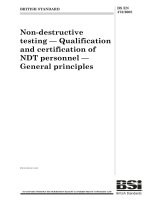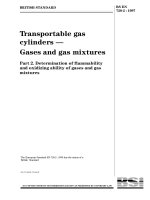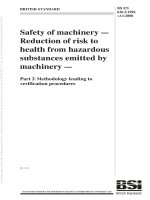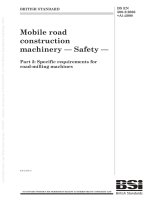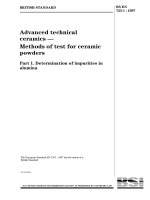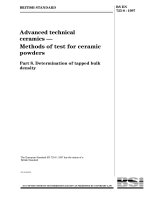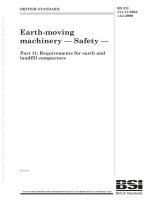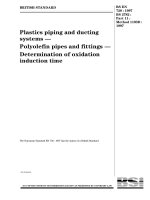Bsi bs en 01233 1997 (2008) bs 6068 2 38 1997
Bạn đang xem bản rút gọn của tài liệu. Xem và tải ngay bản đầy đủ của tài liệu tại đây (161.02 KB, 14 trang )
BRITISH STANDARD
Water quality Ð
Determination of chromium Ð
Atomic absorption
spectrometric methods
The European Standard EN 1233 : 1996 has the status of a
British Standard
ICS 13.060.01
NO COPYING WITHOUT BSI PERMISSION EXCEPT AS PERMITTED BY COPYRIGHT LAW
|
|
|
|
|
|
|
|
|
|
|
|
|
|
|
|
|
|
|
|
|
|
|
|
|
|
|
|
|
|
|
|
|
|
|
|
|
|
|
|
|
|
|
|
|
|
|
|
|
|
|
|
|
|
|
|
|
|
|
|
|
|
|
|
|
|
|
|
|
|
|
|
|
|
|
|
|
|
|
|
|
|
|
|
|
|
|
|
|
|
|
|
|
|
|
|
|
|
|
|
|
|
|
|
|
|
|
|
|
|
|
|
|
|
|
|
|
|
|
|
|
|
|
|
|
|
|
|
|
BS EN
1233 : 1997
BS 6068 :
Section 2.38 :
1997
Confirmed
July 2008
BS EN 1233 : 1997
Committees responsible for this
British Standard
The preparation of this British Standard was entrusted by Technical Committee
EH/3, Water quality, to Subcommittee EH/3/2, Physical, chemical and biochemical
methods, upon which the following bodies were represented:
British Agrochemicals Association Ltd.
British Ceramic Research
British Gas plc
British Soft Drinks Association Ltd.
Chemical Industries' Association
Convention of Scottish Local Authorities
Department of the Environment (Water Directorate)
Environment agency
GAMBICA (BEAMA Ltd.)
Industrial Water Society
Laboratory of the Government Chemist
Royal Society of Chemistry
Soap and Detergent Industry Association
Society of Chemical Industry
Swimming Pool and Allied Trades Association Ltd.
Water Companies Association
Water Research Centre
Water Services Association of England and Wales
This British Standard, having
been prepared under the
direction of the Health and
Environment Sector Board, was
published under the authority of
the Standards Board and comes
into effect on
15 January 1997
BSI 1997
The following BSI references
relate to the work on this
standard:
Committee reference EH/3/2
Draft for comment 93/508225 DC
ISBN 0 580 26789 X
Amendments issued since publication
Amd. No.
Date
Text affected
BS EN 1233 : 1997
Contents
Page
Committees responsible
Inside front cover
National foreword
ii
Foreword
2
Method
Introduction
3
1
Scope
3
2
Normative references
3
3
Determination of chromium by flame atomic absorption spectrometry
3
4
Determination of chromium by electrothermal atomization atomic
absorption spectrometry
6
Annex
A
(informative) Information on pretreatment and digestion of sludge and
sediment samples
8
Tables
1
Precision data for clause 3
5
2
Interfering ions
5
3
Precision data for clause 4
7
BSI 1997
i
BS EN 1233 : 1997
National foreword
This British Standard has been prepared by Technical Committee EH/3 and is the
English language version of EN 1233 Water quality Ð Determination of chromium Ð
Atomic absorption spectrometric methods, published by the European Committee for
Standardization (CEN). It supersedes BS 6068 : Section 2.38 : 1990, which is withdrawn.
NOTE. The tests described in this British Standard should only be carried out by suitably qualified
persons with an appropriate level of chemical expertise. Standard chemical procedures should be
followed throughout.
Cross-references
Publication referred to
EN 25667-2 : 1993
ISO 5667-3 : 1994
Corresponding British Standard
BS 6068 Water quality
Part 6 Sampling
Section 6.2 : 1991 Guidance on sampling techniques
Section 6.3 : 1996 Guidance on the preservation and
handling of samples
Compliance with a British Standard does not of itself confer immunity
from legal obligations.
ii
BSI 1997
EN 1233
EUROPEAN STANDARD
NORME EUROPÊENNE
EUROPẰISCHE NORM
July 1996
ICS 13.060.40
Descriptors: water, quality, chemical analysis, determination of content, chromium, atomic absorption spectrometry
English version
Water quality Ð Determination of chromium Ð Atomic absorption
spectrometric methods
Qualite de l'eau Ð Dosage du chrome Ð
MeÂthodes par spectromeÂtrie d'absorption atomique
Wasserbeschaffenheit Ð Bestimmung von
Chrom Ð Verfahren mittels
Atomabsorptionsspektrometrie
This European Standard was approved by CEN on 1996-05-16. CEN members are
bound to comply with the CEN/CENELEC Internal Regulations which stipulate the
conditions for giving this European Standard the status of a national standard
without any alteration.
Up-to-date lists and bibliographical references concerning such national standards
may be obtained on application to the Central Secretariat or to any CEN member.
This European Standard exists in three official versions (English, French, German).
A version in any other language made by translation under the responsibility of a
CEN member into its own language and notified to the Central Secretariat has the
same status as the official versions.
CEN members are the national standards bodies of Austria, Belgium, Denmark,
Finland, France, Germany, Greece, Iceland, Ireland, Italy, Luxembourg, Netherlands,
Norway, Portugal, Spain, Sweden, Switzerland and United Kingdom.
CEN
European Committee for Standardization
Comite EuropeÂen de Normalisation
EuropaÈisches Komitee fuÈr Normung
Central Secretariat: rue de Stassart 36, B-1050 Brussels
1996 All rights of reproduction and communication in any form and by any means reserved in all countries to
CEN and its members
Ref. No. EN 1233 : 1996 E
Page 2
EN 1233 : 1996
Foreword
This European Standard has been prepared by the
Technical Committee CEN/TC 230, Water analysis, the
Secretariat of which is held by DIN.
Annex A is informative.
This European Standard shall be given the status of a
national standard, either by publication of an identical
text or by endorsement, at the latest by January 1997,
and conflicting national standards shall be withdrawn
at the latest by January 1997.
In accordance with the CEN/CENELEC Internal
Regulations, the national standards organizations of the
following countries are bound to implement this
European Standard: Austria, Belgium, Denmark,
Finland, France, Germany, Greece, Iceland, Ireland,
Italy, Luxembourg, Netherlands, Norway, Portugal,
Spain, Sweden, Switzerland and United Kingdom.
On the elaboration of this European Standard, the
revision of the International Standard ISO 9174 has
been started simultaneously with the intention to
harmonize both standards.
BSI 1997
Page 3
EN 1233 : 1996
Introduction
Chromium occurs in water in the oxidation states III
and VI. The two methods described determine
chromium in both oxidation states, either as acid
soluble chromium or as water soluble chromium,
depending on the sample pretreatment. The method
chosen depends on the concentration of chromium in
the water to be examined.
Some information is given in an informative annex on
pretreatment and digestion of chromium from sludges
and sediments.
1 Scope
This European Standard specifies two methods for the
determination of chromium in water by atomic
absorption spectrometry. The two methods are covered
in separate clauses as follows:
± clause 3: Determination of chromium by flame
atomic absorption spectrometry;
± clause 4: Determination of chromium by
electrothermal atomization atomic absorption
spectrometry.
Clause 3 is applicable to the analysis of water and
waste water when the concentration range is
between 0,5 mg/l and 20 mg/l of chromium. When the
concentration is below 0,5 mg/l, the determination can
be carried out after carefully evaporating an acidified
sample to small volume, taking care to avoid the
formation of a precipitate.
WARNING: The use of evaporation will increase the
effect of interfering substances and therefore for
concentrations below 0,1 mg/l the method in clause 4 is
given.
Clause 4 is applicable to the analysis of water and
waste water when the concentration range is
between 5 mg/l and 100 mg/l of chromium by injecting a
sample volume of 20 ml. It is applicable to the
determination of higher concentrations by using a
smaller sample volume.
2 Normative references
This European Standard incorporates by dated or
undated reference, provisions from other publications.
These normative references are cited at the
appropriate places in the text and the publications are
listed hereafter. For dated references, subsequent
amendments to or revisions of any of these
publications apply to this European Standard only
when incorporated in it by amendment or revision. For
undated references the latest edition of the publication
referred to applies.
EN 25667-2 : 1993
Water quality Ð Sampling Ð
Part 2: Guidance on sampling
techniques
(ISO 5667-2 : 1991)
EN ISO 5667-3 : 1995 Water quality Ð Sampling Ð
Part 3: Guidance on the
preservation and handling of
samples
(ISO 5667-3 : 1994)
3 Determination of chromium by flame
atomic absorption spectrometry
3.1 Principle
The method is based on the atomic absorption
spectrometric measurement of the chromium content
of the acidified sample in a nitrous oxide/acetylene
flame. Measurement at a wavelength of 357,9 nm.
Addition of lanthanum salt to reduce matrix
interferences is necessary.
3.2 Reagents
3.2.1 General
All reagents shall be of recognized analytical grade.
Use deionized water or water distilled from an all glass
apparatus. The water used for blank tests and for
preparing reagents and standard solutions shall have a
chromium content that is negligible compared with the
smallest concentrations to be determined in the
samples.
3.2.2 Hydrochloric acid, HCl, r ≈ 1,18 g/ml.
3.2.3 Nitric acid, HNO3, r ≈ 1,42 g/ml.
3.2.4 Nitric acid, c(HNO3) = 1,5 mol/l.
Introduce about 500 ml of water into a 1000 ml
volumetric flask, add 100 ml of nitric acid (see 3.2.3)
and dilute to the mark with water.
3.2.5 Hydrogen peroxide, H2O2,30 % (m/m) solution.
3.2.6 Lanthanum chloride, (LaCl3), solution with
r(La) = 20 g/l.
Dissolve 23,5 g of lanthanum oxide La2O3, in 200 ml of
hydrochloric acid (see 3.2.2), dilute to 1000 ml with
water and mix.
Appropriate precautions shall be observed when
preparing this solution because the reaction of La2O3
with hydrochloric acid is strongly exothermic.
3.2.7 Chromium solutions
3.2.7.1 Chromium, stock solution, with
r(Cr) = 1,000 g/l.
Dry a portion of potassium dichromate (K2Cr2O7)
at 105 ÊC ± 2 ÊC for about 2 h. Cool and dissolve
2,825 g ± 0,001 g of the dried potassium dichromate in
water. Add 5 ml ± 1 ml of nitric acid (see 3.2.3) and
dilute to 1000 ml with water in a volumetric flask.
1 ml of this stock solution contains 1,00 mg of
chromium.
Store this solution in either polyethene or borosilicate
glass containers at room temperature. The solution is
stable at room temperature for about 1 year if it is
stored in the dark and at a pH between 1 and 2.
NOTE. Chromium stock solutions are commercially available.
BSI 1997
Page 4
EN 1233 : 1996
3.2.7.2 Chromium, standard solution with
r(Cr) = 50 mg/l.
Introduce 50,00 ml ± 0,01 ml of the chromium stock
solution (see 3.2.7.1) into a 1000 ml volumetric flask.
Add 1 ml of nitric acid (see 3.2.3), make up to the
mark with water and mix.
This solution is stable for at least 1 month.
3.3 Apparatus
3.3.1 Atomic absorption spectrometer, equipped with
a chromium hollow cathode lamp and a nitrous
oxide/acetylene burner, and operated in accordance
with the manufacturer's instructions. It is essential that
the manufacturer's safety recommendations are strictly
observed when using the nitrous oxide/acetylene flame.
3.3.2 Glassware
Before use, carefully soak all glassware for about 24 h
in nitric acid (see 3.2.4), then rinse thoroughly with
water.
If low concentrations are expected (for example in
ground water), the glassware should be kept under
nitric acid (see 3.2.4) until use.
Do not use glassware which has been cleaned with
chromic acid.
3.3.3 Membrane filters, of nominal pore
diameter 0,45 mm, washed thoroughly with nitric acid
(see 3.2.4) and rinsed with water (see 3.2.1).
3.4 Sampling and preparation of test portions
3.4.1 General
Collect and preserve samples according to
EN 25667-2 and EN ISO 5667-3. See also annex A.
Collect samples in high density polyethene or
borosilicate glass containers which have been
previously cleaned with nitric acid (see 3.2.4) and then
rinsed with water (see 3.2.1).
3.4.2 Acid soluble chromium
Treat the samples by addition of sufficient nitric acid
(see 3.2.3), immediately after collection, to adjust the
pH to between 1 and 2.
To 90 ml of the acidified sample, or another suitable
aliquot in accordance with the expected concentration,
add 1 ml of hydrogen peroxide (see 3.2.5) and 2 ml of
nitric acid (see 3.2.3). Boil and evaporate to a volume
of approximately 50 ml.
The sample shall not be reduced to dryness.
In the case of samples with low chromium
concentrations this digestion method should be carried
out in an autoclave or a microwave oven.
It is important to follow the manufacturer's
instructions.
Add 10 ml of nitric acid (see 3.2.3) to the evaporated
solution. Transfer the solution to a 100 ml volumetric
flask. Add 10 ml of lanthanum chloride solution (see
3.2.6) into the flask, dilute to the mark with water and
mix.
3.4.3 Water soluble chromium
Filter the sample through a membrane filter (see
3.3.3), as soon as possible after collection, and acidify
the filtrate immediately with nitric acid (see 3.2.3) to
give a pH between 1 and 2.
Add 10 ml of lanthanum chloride solution (see 3.2.6)
to a 100 ml volumetric flask and make up to the mark
with the acidified filtrate, or use another suitable
aliquot in accordance with the expected concentration,
and mix.
3.5 Procedure
3.5.1 Blank test
Carry out a blank test in parallel with the
determination by the same procedure and using the
same quantities of all the reagents as in the sampling
and determination, but replacing the test portion by
water.
3.5.2 Preparation of the calibration solutions
Before each set of determinations, prepare from the
chromium standard solution (see 3.2.7.2) at least five
calibration solutions covering the range of
concentrations to be determined; for example:
pipette 1,0 ml, 2,5 ml, 5,0 ml, 10,0 ml and 20,0 ml of
chromium standard solution (see 3.2.7.2) into a series
of 100 ml volumetric flasks. Add to each flask
depending on the pretreatment (see 3.4.2
and 3.4.3) 10 ml or 2 ml of nitric acid (see 3.2.3)
respectively and 10 ml of lanthanum chloride solution
(see 3.2.6), dilute to the mark with water and mix.
These solutions correspond to chromium
concentrations of 0,50 mg/l, 1,25 mg/l,
2,50 mg/l, 5,00 mg/l and 10,0 mg/l respectively. Proceed
accordingly for other concentration ranges of interest.
3.5.3 Calibration
Set up the instrument in accordance with the
manufacturer's instructions (at wavelength
l = 357,9 nm) using a nitrous oxide/acetylene flame.
Aspirate a calibration solution (see 3.5.2) and
optimize the aspiration, the burner height and the
flame conditions. Adjust the response of the instrument
to zero absorbance with water.
In turn, aspirate the set of calibration solutions (see
3.5.2) and the blank solution (see 3.5.1). Plot a graph
having the chromium concentrations of the calibration
solutions in milligrams per litre as abscissa and the
corresponding absorbance values as ordinate.
Alternatively, data processing facilities can be used to
equate the concentration against the absorbance.
3.5.4 Test portion measurement
Aspirate the prepared test portion (see 3.4.2 or 3.4.3)
into the flame and measure the absorbance for
chromium. After each measurement aspirate water and
readjust the zero, if necessary.
BSI 1997
Page 5
EN 1233 : 1996
3.6 Expression of results
3.7 Interferences
The following ions have been tested and shown not to
cause interference below the concentration given in
table 2.
This information was taken from practical tests carried
out in a working group in 1984.
3.6.1 By reference to the calibration graph obtained
(see 3.5.3) or data processing facilities used, determine
the concentration of chromium corresponding to the
absorbances of the test portion (see 3.5.4) and of the
blank solution (see 3.5.1).
Calculate the concentration of chromium of the sample
using the equation
(A 2 ASO)VW
r= s
VPb
where:
Table 2. Interfering ions
Ion
Concentration Ion
Concentration
mg/l
mg/l
Sulfate
10 000
Chloride
12 000
Sodium
9 000
Potassium
9 000
Magnesium 2 000
Calcium
2 000
r
is the chromium concentration of the sample, in
milligrams per litre;
AS is the absorbance of the test portion;
ASO is the absorbance of the blank;
VP is the volume of the acidified sample in
accordance with 3.4.2 or 3.4.3, respectively, in
millilitres;
b is the sensitivity (slope of the calibration graph)
in litres per milligram;
VW is the volume of the test portion according to
3.4.2 or 3.4.3 respectively, in millilitres.
Iron
Nickel
Copper
Cobalt
Aluminium
Zinc
500
100
100
100
100
100
The total dry residue of the sample shall not
exceed 15 g/l and the conductivity should be lower
than 2000 mS/m.
NOTE. It is possible to determine the effect of possible
interferences by analysing samples spiked with chromium and
various concentrations of the potential interfering substance using
the method of standard additions.
3.6.2 Precision data
An interlaboratory test carried out in
January 1985 yielded the data given in table 1. The
standard solution used was made from deionized
water, spiked with chromium. The water used was a
municipal, biologically treated waste water, spiked with
chromium. The digestion as described in 3.4.2 was
applied; in the atomic absorption spectrometer
apparatus, a hollow cathode lamp was used.
3.8 Test report
The test report shall contain at least the following
information:
a) a reference to this European Standard;
b) a reference to the procedure used;
c) complete identification of the sample;
d) any other information relevant to the procedure.
Table 1. Precision data for clause 3
Type of sample
l
n
xS
X
y
sr
VCr
sR
VCR
Standard solution
11
43
15,0
14,64
97,5
0,084
0,6
0,798
5,5
Water with added concentration
14
56
2,0
2,06
103,0
0,053
2,6
0,218
10,6
where:
l
n
xS
X
y
sr
VCr
sR
VCR
is
is
is
is
is
is
is
is
is
BSI 1997
the
the
the
the
the
the
the
the
the
number of laboratories;
number of measured values (without outliers);
concentration of samples, in milligrams per litre;
overall mean, in milligrams per litre;
recovery rate, in percent;
repeatability standard deviation, in milligrams per litre;
repeatability variation coefficient, in percent;
reproducibility standard deviation, in milligrams per litre;
reproducibility variation coefficient, in percent.
Page 6
EN 1233 : 1996
4 Determination of chromium by
electrothermal atomization atomic
absorption spectrometry
4.1 Principle
Chromium is determined directly in acidified samples
by electrothermal atomization atomic absorption
spectrometry. The sample is introduced into an
electrically heated graphite tube and the absorbance is
measured at a wavelength of 357,9 nm. If necessary, the
standard additions technique is employed.
4.2 Reagents
4.2.1 See 3.2.
4.2.2 Chromium standard solution, with
r(Cr) = 0,5 mg/l.
Add 10,00 ml ± 0,01 ml of the chromium standard
solution (see 3.2.7.2) to a 1000 ml volumetric flask.
Add 10 ml of nitric acid (see 3.2.3) and dilute to the
mark with water.
This solution is stable for at least 1 month.
4.3 Apparatus
4.3.1 Atomic absorption spectrometer, equipped with
an electrothermal atomizer, chromium hollow cathode
lamp and a suitable device for correction of
non-specific absorbants.
4.3.2 Atomizer tubes
The atomizer tubes will vary according to the
instrument used but shall be pyrolytically coated and
pre-conditioned before use in accordance with the
manufacturer's instructions.
NOTE. It is permissible to use a L'vov platform.
4.3.3 Automatic sample injector (autosampler) or
micro-syringe, of appropriate volume.
For high precision, an automatic sample injector is
necessary.
4.4 Sampling and preparation of test portions
Follow the procedures described in 3.4 but omit the
lanthanum chloride solution.
Because of the very low levels of chromium being
determined, take particular care to avoid any
contamination at all stages of sampling and analysis.
4.5 Procedure
4.5.1 Blank test
Carry out a blank test in parallel with the
determination by the same procedure and using the
same quantities of all the reagents as in the sampling
and determination, but replacing the test portion by
water.
4.5.2 Preparation of calibration solutions
Before each set of determinations, prepare from the
chromium standard solution (see 4.2.2) at least five
calibration solutions covering the range of
concentrations to be determined. Prepare the blank
solution (see 4.5.1) and use it for zero setting. The
range of linearity of the calibration graph will depend
on the type of instrumentation used, therefore check
the range of linearity of the graph before use. If the
calibration graph departs significantly from linearity,
use as the highest calibration standard the one with
the highest concentration in the linear portion of the
calibration curve, and then adjust accordingly the
concentration range of the method.
For example, to cover the range between 5 mg/l
and 25 mg/l of chromium, add 1,0 ml, 2,0 ml, 3,0 ml,
4,0 ml and 5,0 ml of chromium standard solution
(see 4.2.2) into a series of 100 ml volumetric flasks,
add in accordance with the procedure (see 3.4.2 and
3.4.3) 10 ml or 2 ml respectively of nitric acid
(see 3.2.3) to each flask. Dilute to the mark with the
water and mix. These solutions contain 5,0 mg/l,
10,0 mg/l, 15,0 mg/l, 20,0 mg/l and 25,0 mg/l of chromium
respectively. Prepare these solutions immediately
before use.
4.5.3 Calibration and determination
Set up the instrument in accordance with the
manufacturer's instructions.
4.5.3.1 Direct measurement
Introduce into the atomizer tube (see 4.3.2) a volume
of calibration solution (see 4.5.2) sufficient to obtain a
satisfactory response on the instrument being used
(see note 1), for example 20 ml. Optimize the setting of
the instrument.
Using an autosampler or syringe (see 4.3.3) inject the
blank solution (see 4.5.1) and calibration solutions
(see 4.5.2).
Measure the instrument's response by using the peak
area (or alternatively the peak height) and construct a
calibration graph as described in 3.5.3.
Introduce the test portion (see 3.4.2 or 3.4.3) and
measure the response by determination of the peak
area (or peak height). Carry out each determination in
duplicate.
NOTE 1. An appropriate test portion volume should be in the
range 5 ml to 30 ml depending on the instrument used, and the
same volume for all test portions, calibration solutions and blanks
should be used.
NOTE 2. A number of matrix modifiers have been suggested for
this determination. Most manufacturers recommend suitable
modifiers for their equipment.
BSI 1997
Page 7
EN 1233 : 1996
4.5.3.2 Procedure using the method of standard
additions
When matrix interferences are suspected, this
procedure should be used.
For example, introduce 5 ml of the pretreated test
portion (see 3.4.2 or 3.4.3) into each of four 10 ml
volumetric flasks. To each flask add 0,5 ml of nitric
acid (see 3.2.3). Pipette respectively into this series of
flasks 0 ml, 0,10 ml, 0,30 ml and 0,60 ml of chromium
standard solution (see 4.2.2). Make each flask up to
the mark with water and mix.
Measure the absorbance of each solution following the
procedure used in 4.5.3.1.
4.6.3 Precision
An interlaboratory test carried out in
January 1985 yielded the data given in table 3. The
standard solution was made from deionized water,
spiked with chromium. The water tested was drinking
water, spiked with chromium. In the atomic absorption
spectrometer instrument, a hollow cathode lamp was
used.
4.6 Expression of results
4.8 Test report
See 3.8.
4.7 Interferences
Determine the effect of possible interfering substances
by the analysis of samples to which chromium at
various concentrations of the potential interfering
substances have been added (see 3.7).
4.6.1 If direct measurement is used (see 4.5.3.1),
determine the concentration of chromium from the
calibration graph corresponding to the peak area (or
peak height) of the sample and of the blank as
described in 3.6.
4.6.2 If the method of standard additions (see 4.5.3.2)
is used, construct a graph with the absorbance values
plotted on the ordinate and the chromium
concentrations plotted on the abscissa. Calculate the
chromium concentration of the test portions from the
value of the negative intercept on the abscissa, taking
into account the blank value and any dilution of the
sample during pretreatment. Alternatively, data
processing facilities can be used for this purpose.
Table 3. Precision data for clause 4
Type of sample
l
n
xS
X
y
sr
VCr
sR
VCR
Standard solution
Water with added concentration
18
18
71
72
25,0
10,0
23,99
10,94
96,03
109,4
0,689
0,690
2,96
6,2
3,586
4,045
14,9
37,0
where:
l
n
xS
X
y
sr
VCr
sR
VCR
is
is
is
is
is
is
is
is
is
BSI 1997
the
the
the
the
the
the
the
the
the
number of laboratories;
number of measured values (without outliers);
concentration of samples, in micrograms per litre;
overall mean, in micrograms per litre;
recovery rate, in percent;
repeatability standard deviation, in micrograms per litre;
repeatability variation coefficient, in percent;
reproducibility standard deviation, in micrograms per litre;
reproducibility variation coefficient, in percent.
Page 8
EN 1233 : 1996
Annex A (informative)
Information on pretreatment and
digestion of sludge and sediment samples
A.1 Pretreatment of sludge and sediment
samples
After sampling, the sludge and sediment samples are
stored in the original bottles (see 3.4.1) in a
refrigerator, or frozen until further treatment.
If the determination is to be carried out on a dry
residue, the sample is preferably freeze dried, or
alternatively dried at 105 ÊC ± 2 ÊC for about 24 h. The
dried sample is homogenized.
NOTE. Dried sludges and sediments may be hygroscopic, and
should therefore be dried again prior to analysis if stored for a
very long time.
A.2 Digestion
As an alternative for the digestion described in 3.4.2,
the following method can be used.
Transfer a precisely weighed amount of the samples to
the digestion flask (a colourless bottle made of
heat-resistant glass or an equivalent glass quality),
volume about 100 ml. The bottle and the screw cap
shall withstand at least a pressure of 200 kPa (120 ÊC).
The largest permissible amount of sample is 1 g of
dried material, or the equivalent amount of wet sample.
Add 20 ml of nitric acid (see 3.2.3). Close the digestion
flask tightly, and heat to 120 ÊC (200 kPa) for 30 min,
following the directions given for the autoclave
(alternatively a microwave oven may be used). Cool to
room temperature, transfer the solution quantitatively
to a 100 ml volumetric flask, and dilute to the mark
with water. After the undissolved material has settled,
the determination is performed on the clear liquid
phase.
BSI 1997
BS EN 1233 : 1997
List of references
See national foreword.
BSI 1997
BSI
389 Chiswick High Road
London
W4 4AL
|
|
|
|
|
|
|
|
|
|
|
|
|
|
|
|
|
|
|
|
|
|
|
|
|
|
|
|
|
|
|
|
|
|
|
|
|
|
|
|
|
|
|
|
|
|
|
|
|
|
|
|
|
|
|
|
|
|
|
|
|
|
|
|
|
|
|
|
|
|
|
|
|
|
|
|
|
|
|
|
|
|
|
|
|
|
|
|
|
|
|
|
|
|
|
|
|
|
|
|
|
|
|
|
|
|
|
|
|
|
|
|
|
|
|
|
|
|
|
|
|
|
|
|
|
|
|
BSI Ð British Standards Institution
BSI is the independent national body responsible for preparing British Standards. It
presents the UK view on standards in Europe and at the international level. It is
incorporated by Royal Charter.
Revisions
British Standards are updated by amendment or revision. Users of British Standards
should make sure that they possess the latest amendments or editions.
It is the constant aim of BSI to improve the quality of our products and services. We
would be grateful if anyone finding an inaccuracy or ambiguity while using this
British Standard would inform the Secretary of the technical committee responsible,
the identity of which can be found on the inside front cover. Tel: 020 8996 9000.
Fax: 020 8996 7400.
BSI offers members an individual updating service called PLUS which ensures that
subscribers automatically receive the latest editions of standards.
Buying standards
Orders for all BSI, international and foreign standards publications should be
addressed to Customer Services. Tel: 020 8996 9001. Fax: 020 8996 7001.
In response to orders for international standards, it is BSI policy to supply the BSI
implementation of those that have been published as British Standards, unless
otherwise requested.
Information on standards
BSI provides a wide range of information on national, European and international
standards through its Library and its Technical Help to Exporters Service. Various
BSI electronic information services are also available which give details on all its
products and services. Contact the Information Centre. Tel: 020 8996 7111.
Fax: 020 8996 7048.
Subscribing members of BSI are kept up to date with standards developments and
receive substantial discounts on the purchase price of standards. For details of
these and other benefits contact Membership Administration. Tel: 020 8996 7002.
Fax: 020 8996 7001.
Copyright
Copyright subsists in all BSI publications. BSI also holds the copyright, in the UK, of
the publications of the international standardization bodies. Except as permitted
under the Copyright, Designs and Patents Act 1988 no extract may be reproduced,
stored in a retrieval system or transmitted in any form or by any means ± electronic,
photocopying, recording or otherwise ± without prior written permission from BSI.
This does not preclude the free use, in the course of implementing the standard, of
necessary details such as symbols, and size, type or grade designations. If these
details are to be used for any other purpose than implementation then the prior
written permission of BSI must be obtained.
If permission is granted, the terms may include royalty payments or a licensing
agreement. Details and advice can be obtained from the Copyright Manager.
Tel: 020 8996 7070.
